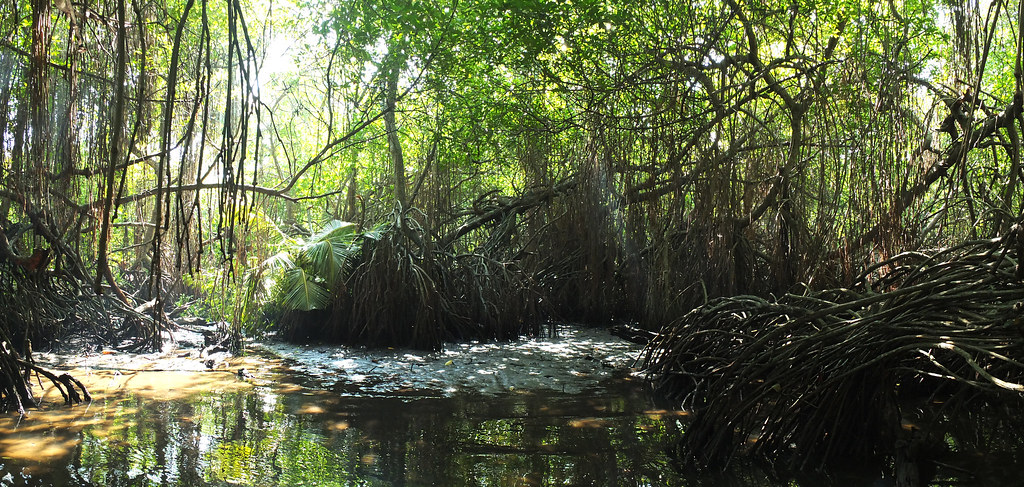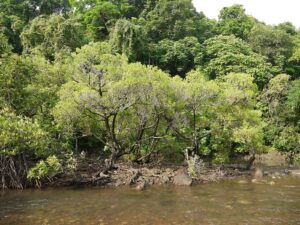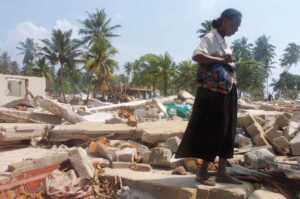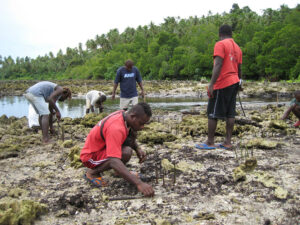December 12, 2023
Mastering the Mangrove: How Sri Lanka Restored Its Specialized Ecosystem

Specialized ecosystems play a crucial role in preserving the multitude of species that have evolved to thrive within their specific environmental niches. These habitats are not only important for sustaining life on our planet but also provide essential services like carbon storage, land protection, and water storage and purification. Specialized ecosystems also serve as important sanctuaries for endangered species, making significant contributions to global biodiversity. The intricate relationships within these specialized ecosystems highlight the pressing need for their protection.1
One of these specialized ecosystems is the mangrove forest, but with human activity such as over-harvesting and deforestation, these critical forests have declined around the world over time. In some cases, however, regulations and policies based upon conservation research has allowed for mangrove forests to be protected. One of the main leaders in mangrove forest conservation is Sri Lanka, a Southeast Asian island nation off the southeastern tip of India, that has used a policy-making framework that weaves in community engagement through ecotourism, educational programs, and conservation organization to provide a safeguard for mangroves. Sri Lanka achieved this success through the cooperation between community and government, and other countries have acknowledged Sri Lanka as an global leader in the protection of mangrove forests. So, what are mangrove forests and why are they so important in Sri Lanka?

Mangrove forests are intertidal-wetland forests. These unique ecosystems include trees and shrubs that are able to thrive on salty habitats. They are mostly located along ocean coastlines in tropical and sub-tropical regions where conditions are constantly changing. These conditions include fluctuations in water level due to daily tides, salinity changes related to both short- and long-term weather conditions, tropical weather patterns such as cyclonic storms (hurricanes, typhoons), or calm water behavior, which allows for nutrients and sediments to be deposited.
This wide-range in environmental conditions on the margins of the ocean allows mangrove forests to be one of the most species-rich ecosystems on the planet, as they create a habitat for both saltwater and freshwater organisms. The abundance and richness of different species contribute to the high biodiversity of these ecosystems, and is a major factor in their importance to coastal regions.2
Not only do they have high biodiversity, but mangrove forests also provide many ecosystem services to human populations. Mangrove forests serve as protection from coastal storms and hurricanes in the form of providing vegetation-barriers between the ocean and urban areas. The high amount of vegetation and their supporting root systems in these forests also stabilize loose soils on beaches and in intertidal zones, preventing sediment erosion and stopping oceans from creeping past the shoreline. Under storm conditions, the mangrove forest provides a critical buffer against storm surge. The forests also help reduce the amount of atmospheric carbon dioxide by serving as sinks that absorb carbon dioxide and thus contribute to reducing the effects of human-caused climate change. Lastly, mangrove forests can serve as areas of cultural significance and promote business opportunities through ecotourism.3
Unfortunately, by the close of the 20th century, mangrove forests had declined in Sri Lanka from human activity such as over-harvesting and deforestation. Deforestation was promoted by the introduction of shrimp farming to these lands, a profitable business outside of Sri Lanka in the international economy that took off in the late 70’s and early 80’s.4 The demand for shrimp was detrimental for areas in Sri Lanka with mangrove forests, as deforestation cleared land to construct shrimp ponds. The success of these initial shrimp ponds set off a chain reaction, where increased market demand for seafood led to mangrove forests were being cleared in favor of shrimp farming. As a result, the area of mangrove forests decreased in Sri Lanka with dire consequences for both the environment and the communities associated with these lands.
Cleared forests removed ecosystem services in many regions of Sri Lanka. These services included erosion prevention, which left Sri Lankan coasts more vulnerable to natural disasters and flooding. The loss of vegetation also caused increased carbon release into the atmosphere, worsening the human footprint of human-induced carbon dioxide. Biodiversity was decreasing as well, resulting in lower fishing yields over time.5 Reduced biodiversity affected local fisheries, and became a threat to food and resource security for local residents. Fresh groundwater was also being depleted through this process, and contaminants from the deforestation process were polluting what was formerly a mangrove forest waterbody.

The consequences of shrimp aquaculture were recognized over time, and the public push for policies and regulation to protect mangrove forests gained momentum. The key moment for the Sri Lankan government was when the 2004 Indian Ocean Tsunami destroyed most of the remaining mangroves in Sri Lanka, while at the same time causing major damage to coastal urban areas. What once hosted a biodiversity of 20 different mangrove species and provided shoreline stabilization and storm protection, had been destroyed by both shrimp farming and damage from the tsunami was amplified.
Following the tsunami, it was reported that a lack of mangrove forest vegetation had caused the deaths of about 6,000 residents of the village of Wanduruppa. In comparison, at Kapuhenwala, a village with a high density of mangrove vegetation, only two deaths were reported. These contrasting results clearly showed the protection that healthy mangrove forests could provide from natural disasters.6
This scientific evidence spoke loudly, and at this moment, mangrove forest conservation became a crucial initiative for the welfare of Sri Lanka and its ecosystems. Because the loss of mangrove forests began to affect Sri Lankan residents, communities actively engaged to protect mangroves. At the same time, the Sri Lankan government began passing policies focused on mangrove preservation and protection. Community planting initiatives coordinated by both government agencies and non-government organizations (NGOs) allowed the community to engage in restoring mangrove populations along previously deforested coastal areas. These efforts achieved two things: the restoration of mangroves to Sri Lanka’s coast, and the education of Sri Lankans on the importance of mangrove conservation.7 Through these efforts, Sri Lanka officially became the first country across the world to fully protect all of its mangrove forests in 2015.8
These efforts and environmental accomplishments are recognized outside of Sri Lanka. The Sri Lankan NGO Sudeesa, the Small Fishers Federation for women and young adults focused on farming and fishing, grabbed the attention of Seacology. A California-based organization, Seacology was established with the mission to fight for island conservation around the world, and in 2015 decided to narrow its focus on mangrove conservation. Thanks to the inspiring work of Sudeesa, Seacology launched the Sri Lanka Mangrove Conservation Program, a non-profit program aimed at being the first nationwide conservation program for mangroves. It funded ecological protection of mangroves, and provided support for the citizens living in these areas. In 5 years, the program was able to map over 36,000 acres of mangroves and protected them from deforestation. By 2020, 1,200 acres of mangroves had been restored with the replanting of almost 1 million mangrove seedlings. The project also established the world’s first mangrove museum as a popular ecotourism destination. The Lanka Mangrove Museum opened on July 26, 2016, a date also established as International Mangrove Day.
Sudeesa and Seacology found a way to blend government initiatives and Sri Lankan NGO efforts in a push for mangrove protection in Sri Lanka. This passion provided a positive feedback loop for mangrove protection, as increased community involvement allowed for new legal regulation and policy to be passed in favor of mangrove protection.9 The cooperation of the Sri Lankan government and Seacology extended beyond environmental protection into the hearts of Sri Lanka’s communities. After the ruin left by more than 25 years of civil war, many Sri Lankan women were left widowed when the war ended in 2009. Sudeesa and Seacology established a funded business training program for women in war-torn provinces, funding more than 12,000 women for startup businesses. This co-op also included training both women and children for mangrove conservation. Everything from education on the importance of mangrove conservation and its benefits to teaching the physical process of planting and sustaining a mangrove forest was included in the effort. Not only were members of the community educated on the labor aspects of conservation, but they were trained to one day be able to organize and lead as project managers for mangrove protection projects. This work laid a foundation of conservationists that could be continued for generations and would provide a good source of employment opportunity.10
The Suddesa/Seacology program’s success was not only an inspiration to Sri Lanka, but was recognized across the globe. In 2018, the United Nations recognized the impact that restoring mangrove forests would have on climate change, and awarded Seacology with a United Nations Framework Convention on Climate Change (UNFCCC) Momentum for Change Lighthouse Activity Award. The project has also been showcased in numerous countries such as Sweden, where it was presented in Stockholm during World Water Week, a global conference that brings together leaders in the field of water conservation.11

The story of Sri Lanka’s success in protecting its mangrove forests extend far beyond the borders of the island and continues to set the international standard of mangrove conservation. Due to the hard work and dedication of Sudeesa and Seacology, the Sri Lanka Mangrove Conservation Program concluded on June 3, 2020. The project inspired Seacology to begin further mangrove conservation programs in other island countries such as the Dominican Republic, Indonesia, the Philippines, and many more. But the work in Sri Lanka continues, as the country sees a rebirth in mangrove conservation following the pause taken during the COVID-19 global pandemic.
In a world where shrimp farming is in high demand, however, mangrove deforestation continues and most governments do not consider the voice of their communities. For example, in Bangladesh, the degradation of mangrove forests is an issue in the Sundarbans mangrove forest, where this society is cutting down large masses of trees to make room for shrimp farming. Poor government regulation is harming both the forests and the communities near the forests. But by closing the gaps between the needs of the village and the needs of the Sundarbans, politicians can protect both the mangrove forests and village residents.12
Bangladesh is just one example of the continuous struggle for mangrove conservation, and many other developing countries face similar issues. These issues could be solved by looking to the success in Sri Lanka, a country that accomplished a seemingly impossible task through community engagement and global outreach.
- Devictor V, Clavel J, Julliard R, Lavergne S, Mouillot D, Thuiller W, Venail P, Villéger S, Mouquet N. 2010. Defining and measuring ecological specialization. Journal of Applied Ecology. 47(1):15–25. doi:10.1111/j.1365-2664.2009.01744.x. ↵
- Friess DA. 2016. Mangrove forests. Current Biology. 26(16):R746–R748. doi:10.1016/j.cub.2016.04.004. ↵
- Veettil BK, Wickramasinghe D, Amarakoon V. 2023. Mangrove forests in Sri Lanka: An updated review on distribution, diversity, current state of research and future perspectives. Regional Studies in Marine Science. 62:102932. doi:10.1016/j.rsma.2023.102932. ↵
- van der Pijl W. 2021. Sri Lanka’s Rapid Transition to L. Vannamei Shrimp Produciton. The Shrimp Blog. https://shrimpinsights.com/blog/sri-lankas-rapid-transition-l-vannamei-shrimp-production#:~:text=As%20described%20in%20the%20ShrimpTails,western%20part%20of%20the%20country. ↵
- Wickramasinghe S, Wijayasinghe M, Sarathchandra C. 2022. Sri Lankan Mangroves: Biodiversity, Livelihoods, and Conservation. In: Das SC, Pullaiah, Ashton EC, editors. Mangroves: Biodiversity, Livelihoods and Conservation. Singapore: Springer Nature Singapore. p. 297–329. (accessed 2023 Nov 25) https://link.springer.com/10.1007/978-981-19-0519-3_13. ↵
- Blaikie P, Mainka S, McNeely J. 2005. The Indian Ocean tsunami Reducing Risk and vulnerability to future natural disasters and loss of ecosystem services. ↵
- Veettil BK, Wickramasinghe D, Amarakoon V. 2023. Mangrove forests in Sri Lanka: An updated review on distribution, diversity, current state of research and future perspectives. Regional Studies in Marine Science. 62:102932. doi:10.1016/j.rsma.2023.102932. ↵
- Smith L. Sri Lanka to become the first nation in the world to protect all its mangroves. The Guardian. ↵
- Peterson K. 2020. Mangroves–and coastal women–thrive in Sri Lanka. Seacology. ↵
- Peterson K. 2020. Mangroves–and coastal women–thrive in Sri Lanka. Seacology. ↵
- World Water Week. 2023. https://www.worldwaterweek.org/about. ↵
- Taher TB, Althaus CE, Tranter PJ, Evans MC. 2023. Impacts of shrimp aquaculture on the local communities and conservation of the world’s largest protected mangrove forest. Environmental Science & Policy. 147:351–360. doi:10.1016/j.envsci.2023.07.002. ↵
Tags from the story
biodiversity
forest conservation
mangrove
shrimp farming

Samantha Aragon
Hi Diego, great article! I never knew how many benefits mangroves could provide, specifically their role in land protection. It was unfortunate to see how money drove the industries in Sri Lanka to pick up shrimp fishing, but I’m also happy to see how organizations like Seacology are able to promote land conservation. In the article, it is stated that many developing countries like Bangladesh are facing deforestation issues, but I wonder if developed countries are also undergoing fights against nature conservation.
22/03/2024
6:30 pm